
Click Me!
Kosmoceratops richardsoni had a horn over its nose, one atop each eye, one at the tip of each cheekbone, and 10 across the rear margin of its bony frill. The dinosaur, named Kosmoceratops richardsoni, had a horn over its nose, one atop each eye, one at the tip of each cheekbone, and 10 across the rear margin of its bony frill. Its head is the most ornate of any dinosaur known.
The name comes from the Latin "kosmos" for ornate, the Greek "ceratops" meaning horned face, and the latter part honors Scott Richardson, the volunteer who discovered two skulls of this animal in 2007.
IN PICTURES: Fearsome dinosaurs
"Kosmoceratops is one of the most amazing animals known, with a huge skull decorated with an assortment of bony bells and whistles," said researcher Scott Sampson, a research curator at the Utah Museum of Natural History.
Kosmoceratops was perhaps 15 feet (5 meters) long and weighed about 5,500 pounds (2,500 kilograms) when alive.
Its larger relative, also newly discovered, is named Utahceratops gettyi – honoring Mike Getty, paleontology collections manager at the Utah Museum of Natural History, who discovered this behemoth in 2000. It possessed a large horn over the nose, and short, blunt eye horns that projected strongly to the side rather than upward, much more like the horns of modern bison than those of Triceratops and its other relatives, known as ceratopsians.
Utahceratops was roughly 18 to 22 feet (6 to 7 meters) long and about 6 feet (2 meters) tall at the shoulder and hips, and overall weighed about 6,600 to 8,800 pounds (3,000 to 4,000 kilograms).
Utahceratops possessed a skull about 7 feet (2.3 meters) long, prompting researcher Mark Loewen, a paleontologist at the Utah Museum of Natural History, to liken it to "a giant rhino with a ridiculously super-sized head."
Although scientists have speculated that the ornate horns and frills of ceratopsians might have helped fight off carnivores, for the newly discovered dinosaurs
Land of the lost
These new beasts were unearthed in Grand Staircase-Escalante National Monument in southern Utah. "Grand Staircase-Escalante National Monument is now one of the country's last great, largely unexplored dinosaur boneyards," Sampson said.
Back when these behemoths were alive roughly 76 million years ago, the area was part of the island continent of Laramidia, which was born when a warm, shallow sea dubbed the Western Interior Seaway flooded the central region of North America 95 million years ago. This split the eastern and western portions of the modern continent for 27 million years until sea levels fell again. Western North America formed a roughly Australia-sized continent called Laramidia, stretching from Mexico in the south to Alaska in the north, while Eastern North America was known as Appalachia.
Most known dinosaurs from Laramidia were concentrated in a narrow belt of plains sandwiched between the seaway to the east and mountains to the west. Utah was located in the southern part of the continent, and Kosmoceratops and Utahceratops lived in a swampy, subtropical environment about 60 miles (100 kilometers) from the seaway.
Provincial puzzle
These new dinosaurs are part of a wave of discoveries made in the southern part of Laramidia that could help solve a mystery roughly a half-century old.
Starting about 50 year ago, paleontologists began noticing that although they found major groups of dinosaurs all throughout Laramidia, different species of these groups appeared in the north than in the south — for example, Alberta and Montana versus New Mexico and Texas. Such provincialism seemed odd, given the small size of the continent. For comparison, there are currently five rhino- to elephant-sized mammals on the entire continent of Africa, while there may have been more than two dozen giant dinosaurs living on Laramidia, a landmass about one-quarter that size.
Apparently, some kind of barrier existed near the latitude of northern Utah and Colorado that limited the exchange of dinosaur species north and south. Perhaps there were physical barriers such as mountains or rivers, "but we have no evidence of such then," Sampson said. "That means that perhaps these areas were separated by ecology, with different plants found in both regions, which in turn would spur different sets of herbivores to evolve and then different sets of carnivores."
Investigations into the roots of this provincialism have been severely limited by the dearth of dinosaurs found in the southern part of Laramidia compared with the north. Scientists are now overcoming this shortfall, unearthing more than a dozen species of dinosaurs in the last decade in Grand Staircase-Escalante National Monument.
"One reason that these dinosaurs weren't found before was the challenge that Grand Staircase-Escalante National Monument poses," Sampson said. "It's nearly 2 million acres of high desert, and it's so rugged that indigenous peoples to pioneers to people today usually go around it instead of trying to go into it."
Many places the researchers dug at were 25 miles (40 km) from the nearest paved roads. "We often had to hike up rugged terrain, bringing in not just food and water, but jackhammers and rock-saws, as well as plaster and burlap to wrap the fossils in big protective jackets that we would get helicopters to airlift," Sampson told LiveScience. "These relatively unexplored treasure troves were exciting places to be."
Too many giants?
In addition to Kosmoceratops and Utahceratops, scientists have unearthed a variety of other plant-eating dinosaurs in the national monument, including duck-billed hadrosaurs, such asGryposaurus monumentensis, armored ankylosaurs, and dome-headed pachycephalosaurs. They have also dug up large and small carnivorous dinosaurs, from raptor-like predators, such asHagryphus giganteu, to mega-sized tyrannosaurs — not T. rex, but its smaller relatives. These findings help confirm that dinosaurs living on Laramidia were divided into provinces.
Paleontologists have also found a variety of fossil plants, insect traces, clams, fishes, amphibians, lizards, turtles, crocodiles, and mammals, helping them picture this ancient ecosystem in its entirety.
The mystery of why these provinces occurred remains. There is also the enigma of how so many giant animals could live in such a relatively small area — perhaps food was abundant, or they needed to eat less than large herbivores do today.
"Now we get to try and put together the world of dinosaurs, to understand the ecosystems they lived in," Sampson said. "Their world was similar in many ways to our own, but in some ways was radically different, and we may have to rethink some of our basic assumptions of how such large-bodied animals lived."
Many more dinosaurs likely remain to be unearthed in southern Utah. "It's an exciting time to be a paleontologist," Sampson added. "With many new dinosaurs still discovered each year, we can be quite certain that plenty of surprises still await us out there."
The Adasaurus |
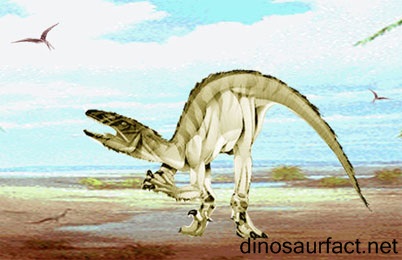
The one species Adasaurus Mongoliensis was obviously named after the country. Both fossil skeletons were found and described by Barsbold in 1983. The first discovery consisted of a skull, all three pelvis, along with many misalainious body bone parts. The second discovery was the lower half of its body including the hindlimbs and feet etc. Adasaurus is part of the Dromaeosaurinae family making it closely related to the Deinonychus, Velociraptor, Microraptor, and Buitreaptor. So they have much in common. They are smaller, have sharp claws, a long tail, feathers possibly, etc. |
The Scutellosaurus |
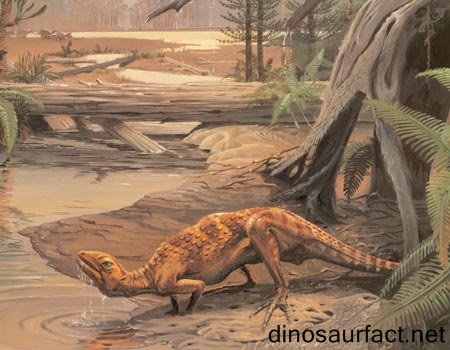
|
The Lariosaurus |
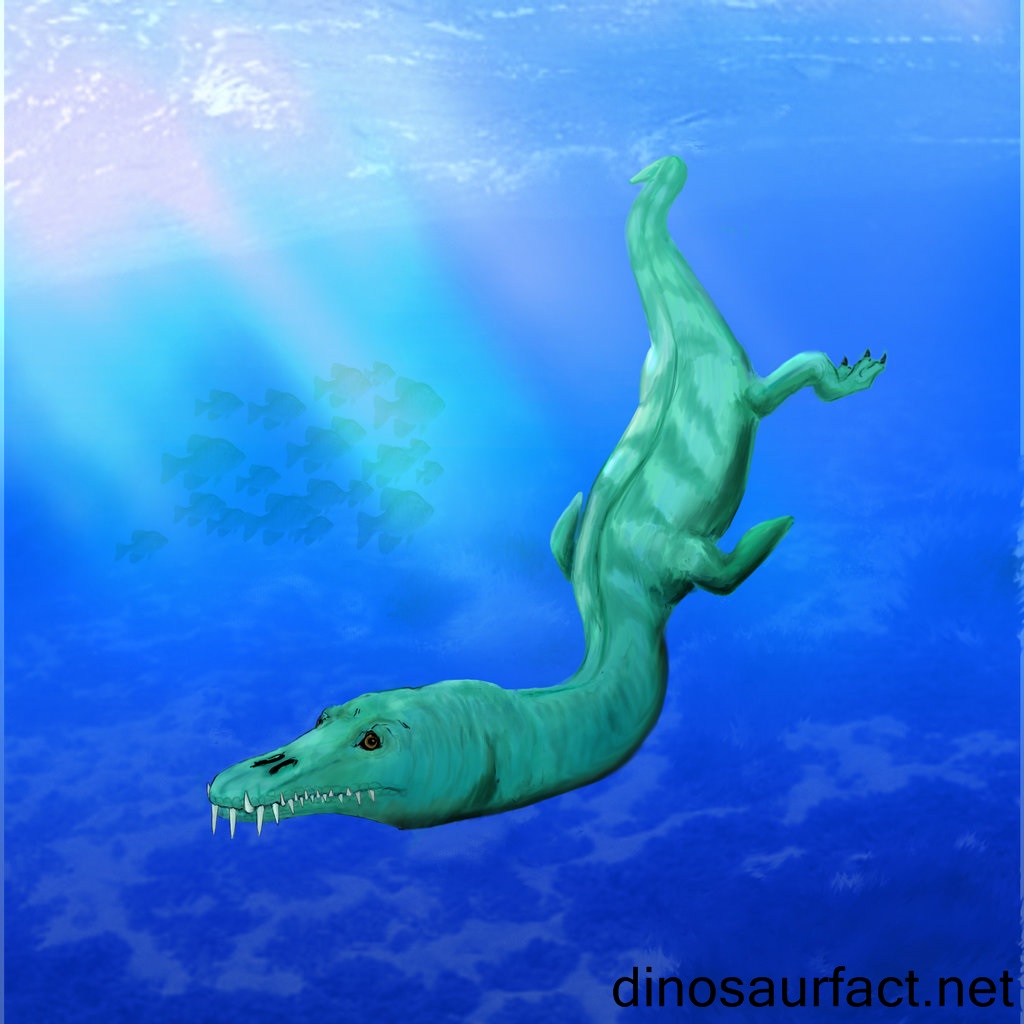 Lariosaurus was an extinct genus, which belonged to the suropterygian family. It is known to have lived during Triassic period. This dinosaur received its name from Curioni in the year 1847. It is known to have belonged to the nothosaur order. The term Lariosaurus was derived from the Greek word, the meaning of, which is lario lizard. This term is pronounced as lah-ree-oh-sore-us. Lariosaurus is known to have possessed small flippers and short neck as compared to its relatives. Its hind limbs are known to have possessed five-toe feet, while its front legs were paddles. The stubbier toes and the shorter neck of Lariosaurus might have limited its swimming ability to a certain extent. It was basically a water living dinosaur, but it has been found that it would have spent time in land as well for hunting prey. It has been found that Lariosaurus can grow up to a length of 60cms (i.e.) 2 feet. From the fossils of Lariosaurus, it has been found that it had two juvenile placodonts, with the help of which the researchers assumed that it might have had the same diet as nothosaurs. The fossils of Lariosaurus were found at the coastal areas of Western Europe . Apart from Europe the fossils were found in Spain , China and France as well. It was an aquatic reptile that might have lived in coastal and brackish waters. Lariosaurus was distinctly un-hydrodynamic with its short legs and arms, knobby body and primitive flippers. From this statement is very clear that it was the first among the other breed of aquatic reptiles like pliosaurs and plesiosaurs of the Cretaceous and Jurassic periods. Apart from its ancient derivation, Lariosaurus was noted to be the smallest aquatic reptile discovered so far. This reptile was very small and later other dinosaurs, which came under this category were somewhat bigger as compared to this swimming lizard. From the fossils of lariosaurus the following information had been discovered: • The skull of lariosaurus is elongated and it had a very long postorbital region and elongated upper temporal fenestae. The anterior teeth and the rostrum are interiorly constricted interlocking each other when the lariosaurus closes its jaws. • The vertebral column consisted of at least 39 caudal, 5 sacral, 20 dorsal and 22 cervical vertebrae. But, these figures differ from another dinosaur of the same family called lariosaurus balasamii. • The dorsal ribs are pachyostotic and the cervical ribs show a distinct anterior process. • The caudal ribs do not extend beyond 15-16 caudal vertebra and decrease in length rapidly. • As in other lariosaurus the front limbs would have been stouter than the hind limbs. It would have used its fore limbs effective for the purpose of swimming. • It would have had a stout hemerus. • In lariosaurus the researchers found a peculiar ulna (i.e.) the radius of the ulna is narrower and it is greatly broadened. In between the ulna and the radius there was a wide spatium interosseum. From the above points, it is clear that lariosaurus was very primitive as compared to other members of its family. |
The Arambourgiania |
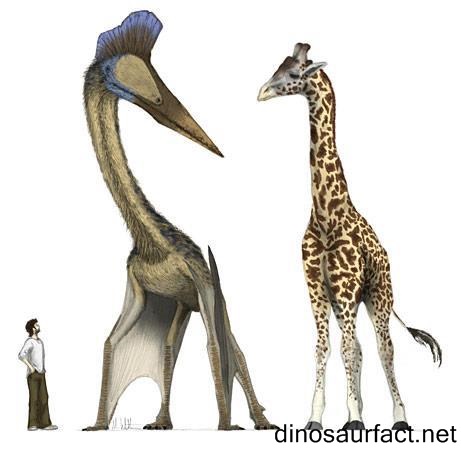
Arambourgiania is a creature, which belongs to the category of pterosaur and it is known to have lived in the late cretaceous era. It is regarded as one among the largest member of the family of pterosaurs. During the initial forties, a two feet long fossil bone of Arambourgiania was found on the Amman-Damascus railway line near Ruseifa. Later in the year 1943, it was taken to the attention of British archeologists. Later in the year 1953, the fossil was transmitted to a museum at Paris and was inspected by Camille Arambourg. In the year 1954, Camille Arambourg came to a conclusion that the fossil was the wing metacarpal of Arambourgiania. In the year 1959 he named a new species and genus called Titanopteryx philadelphiae. The meaning of this term is titan wing and this was derived from a Greek word. In 1975, another researcher named Douglas Lawon came to a conclusion that the fossil was not metacarpal, but it was cervical vertebra. In the eighties another Paleontologist from Russia named Lev Nesov found that there is already a creature in the name Titanopteryx philadelphiae and so, in the year 1987, he renamed the creature as Arambourgiania to honor the first researcher Camille Arambourg. Even though, the name was changed, the pterosaur was informally called by the old name itself. After that in the year 1995, two researchers, Eberhard Frey and David Matrill travelled to Jordan, where the fossils of Arambourgiania was initially found, to find whether they will be able to get further information on this species. But, they were not able to find any further fossils. The initially found fossil is presently available at the University of Jordan and two researchers named Frey and Martill are making further study on the fossil. The fossil consists of a stretched out cervical vertebra. Initially, when the fossil was found it was about 62 centimeters long, but later it was cut into three parts. At present, the middle section of the fossil is missing. Most of the fossil consists of an interior mould or infilling and in most of the surfaces, the thin bone walls are known to be missing. The whole vertebra was also not found and in its latter end a small piece was also missing. Since many parts of the fossils are missing, the researchers were able to judge the size and other features of Arambourgiania, only on the basis of another creature of the same family called Quetzolcoatlus. From this, they estimated that the total length of the Arambourgiania would have been around 78 centimeters. They also estimated that the length of the neck would have been around three meters. They made all the calculations only on the basis of the size of Quetzolcoatlus and they decided it to be in 1:18 ratio. On this basis, they concluded that its wingspan would have been twelve to thirteen meters long. Arambourgiania is classified under the kingdom of Animalia , under chordate phylum, suropsida class, pterosauria order and pterodactyloidea suborder. It is also classified under the family of Azhdarchidae. |
Dinosaurs were animals that lived millions of years ago.
Many dinosaurs were very big. But some were as small as chickens are today.
Most dinosaurs ate only plants. Some dinosaurs ate other animals. They were meat eaters.
Scientists aren't sure what color dinosaurs were. Some think dinosaurs might have been as colorful as many birds are today.
In 1902, part of a huge skeleton was uncovered in Montana. Later, another was found in Wyoming. From these bones the American paleontologist Henry Fairfield Osborn drew up the first pictures of this giant creature. He named it Tyrannosaurus Rex (meaning 'king of the tyrant reptiles') because it was the biggest meat - eating dinosaur then known to have lived on Earth.
Scientists in Argentina, South America, claim to have found the world's oldest dinosaur. This creature, called Herrarasaurus, is said to be 230 million years old.
Dinosaurs sometimes had accidents, and fossil bones have been found with fractures in them.
The most complete skeleton of a Stegosaurus ever found has been dug up at the foot of the Rocky Mountains in Colorado. It had to be hauled out of the earth by an army helicopter.
Your dentist's drill has other uses. In the laboratory, scientists often use dental drills to clear and prepare dinosaur bones.
Tracks left in the mud by dinosaurs provide clues as to how quickly they moved. By measuring the distance between footprints, experts have worked out that some dinosaurs could have reached speeds up to 25 mph.
Velociraptor was probably very fierce. A fossil found in Utah, shows its claws may have been up to 15 inches in length--as long as a three-year-old child's arm. These claws formed very effective hooks with which to hold prey.
The Libonectes |
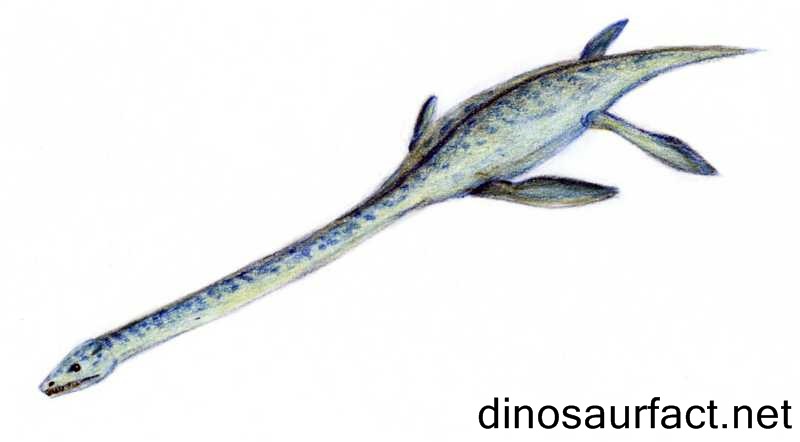 After the success of the film ‘ Jurassic Park ' many children are very much interested in collecting information regarding the different varieties of dinosaurs that lived millions of years ago. The Libonectes were not of the dinosaur specie category but under the marine reptile family called plesiosaurs. Plesiosaurs are marine reptiles lived during the early Jurassic period or Triassic period. Even though plesiosaurs were believed to be vanished, some people claim that animals alleged to be living in certain lakes might be living plesiosaurs. They make a claim seeing the animal Nessie, which is known to be living in Scotland, Loch Ness and in the Champlain Lake in the United States of America. Plesiosaurs were classified into two major sub-groups. They are larger headed, short-necked ‘pilosaurids' and small headed, long-necked elasmosaurs. Libonectes belong to the second category (i.e.) it had a long neck with small head. Even though, this classification has been made, some researchers do not agree upon this classification of Plesiosaurs. This is because, according to them some of the plesiosaurs falling under the first category (i.e.) pilosaurids also were to a certain extent related to the second category elasmosaurs in their appearance. Different dinosaurs coming under the category of pilosaurids were ranged from 2.4 to14m long (i.e.) 8 to 46 feet long in size. With the evolution, the pilosaurids with longer neck (i.e.) elasmosaurs tended to get even longer necks. All these had short tail and broad body. Libonectes is an extinct genus belonging to the plesiosaur order. It was known to have been lived in the late Cretaceous period. It was known to have been lived around 65 million years ago. It was an omnivorous (i.e.) it would have eaten both meat and plants. From the fossils of Libonectes, it was found that it can grow around 23-47 feet long (i.e.) 7-14m long and it was related to Elasmosaurus since it possessed the same body structure as that of the Elasmosaurus. It had large flippers and a short tail. Its skull had forward facing long teeth perfectly designed for catching squid and slippery fish. It would have kept its body strong by swallowing rocks and its four strong flippers would have helped it to swim quickly. It is believed that it controlled its buoyancy by consuming the bottom sea rocks. It was once believed that plesiosaurs would have been able to raise their neck above the surface of the water. But, from the fossils of Libonectes, it was found that the base of the neck was too stiff. So it might have able to move its head only slightly up and down and side to side. Libonectes is classified under Animalia kingdom, Chordata phylum, Sauropsida class, plesiosauria order and under the sub order plesiosauroidea and it belonged to the family of elamosauridae. In Texas, the specimen of different dinosaurs is being kept for display and they also have the skull of Libonectes. According to them, they found the specimen near Cedar hills in the Dallas county of Texas. Hope you might have got the required information regarding Libonectes |
The Segisaurus |
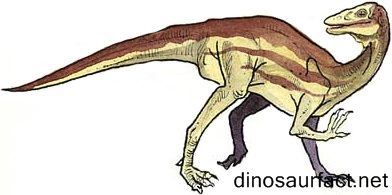 Nowadays, kids are very much interested in learning more information about different types of dinosaurs especially after the great hit of Jurassic park film. There are different types of dinosaurs like killer dinosaurs, plant eating dinosaurs, armored dinosaurs, duck bills dinosaurs and flying dinosaurs. One such dinosaur is segisaurus, which is a meat eater. Segisaurus was known to be lived in the early Jurassic period in North America (i.e.) 200 million years ago. The term ‘Segisaurus' represents reptile of Segi. Segi is nothing but the location from where this dinosaur was discovered. The term is spelled as ‘Say-ee-sore-uss'. Segisaurus was known to have been one meter (i.e.) three feet long. Researchers say that Segisaurus would have weighed around eleven pounds. This dinosaur belongs to the Theropoda class of dinosaurs. As said earlier, it is a meat eater and it would have eaten small animals. Since it belonged to a very early period, only a few bones of Segisaurus were found and from the bones it was discovered that it would have been a fast runner and it would have been able to dart from one side to another when it hunted the prey. The remains of Segisaurus was found by Max Littlesalt in the year 1933 in Segi Canyon, after finding the bones he reported it to the archeologists and research was done using the remains. The research was done by Charles Lewis Camp, who was a paleontologist. The remains consisted of portions of pelvis, limbs and vertebrae. It was found that Segisaurus would have resembled the well-known dinosaur called coelophysis. The only difference between these two dinosaurs would have been the bone type. Segisaurus would have had a solid bone, while coelophysis would have had a hollow bone. From further research, it was found that Segisaurus would have been related closely to procompsognathus. It was found that it would have been in the size of a goose, it was insectivorous and nimble, and even it might have consumed meat as well. It would have had a bird like body structure with an elongated and flexible neck and stubbiest body. Segisaurus might have had powerful legs with three toes and the leg would have been long as compared to the length of its body. It also had a long forearms and long tail. Scientists discovered clavicles in the bone of Segisaurus and they found it to be strange since clavicles were present only in dinosaurs that belonged to much earlier era. When the specimen of Segisaurus found it was linked with a sitting hen since the position of the dinosaur showed that. Other dinosaurs generally use the position of a sitting bird for staying sheltered and for sleeping. From the specimen it was found that Segisaurus would have been submerged in a sand layer, when it was sitting because of which it would have died. Along with the specimen of Segisaurus no other den or nest materials was found and so its hatching habits were not known. Very recently (i.e.) in September 2005, the remains of Segisaurus was again investigated and scientists found that it would have been a coelophysoid and would have been a relative of procompsognathus. |
The Dallasaurus |
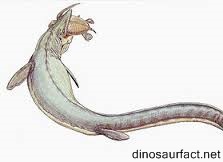 Dallasaurus belonged to a family of Mosasaurs which were serpentine lizards. Dallasaurus were found in Dallas County which is located in Northern Texas . The meaning of this name Dallasaurus is lizard of Dallas . Their partial remains do not tell us much about them. However paleontologists have tried and are still trying to find more information on them. They are found in two parts. The first part that was found had skull but some body parts were missing. The second part had some body parts but had no skull. Studies then have revealed that these are the oldest mosasauroid along with Russellosaurus to be found in North America . Van Turner discovered this fossil some 16 years ago in Dallas . It took him many years to discover the mystery behind this mosasaur. In addition to this, the fossils were accidentally excavated at a construction site. They were sort of amphibians as they could live on land as well on lands. It is believed that they lived 92 million years ago. Interestingly Dallas was mostly under water then. These creatures were three feet long and lived in shallow waters of the sea as well as the shores. After a lot of research, paleontologists have proven that they had well developed limbs. These limbs enabled them to walk on land and water properly. In fact, Dallasaurus gives an insight to Mosasaurs. So in a way the study of Dallasaurus reveals the existence of some prehistoric creatures which could live both on land and water. These creatures were exclusively found in the North American continent. The fossils of Dallasaurus came handy for further research. Studies revealed that in later stages, the limbs of Mosasaurs developed into fins. They dominated the waters when the dinosaurs dominated the land. In reality the Dallasaurus was the first of a kind of this breed. Michael Polcyn of Southern Methodist University and Guadalupe National Park 's Gordon Bell Jr. in Texas researched on these fossils. Their research was a major breakthrough and thus we have the information on Dallasaurus. Their investigation throws light on the habitat, weather conditions they lived in and some more specific details. Dallasaurus is a missing link between the prehistoric animals and their evolution. What can be further said is that there were two groups of dinosaurs. One remained in the land and the other went to the sea, settled and lived there. These two types of dinosaurs lived millions and millions years ago and ruled the world. They probably had a harmony and an unsaid power equation between them. Dallasaurus also became extinct around the time when dinosaurs also became extinct. They mastered the marine life and lived according to your wishes in the waters. They ruled like kings and were very powerful creatures. Soon they started to control the waters and became predators of the water. A Dallasaurus is a discovery of its kind. It is something that scientists, paleontologists and archeologists are still working on. This is that area of research and study that attracts a lot of attention! |
The Jeholopterus |
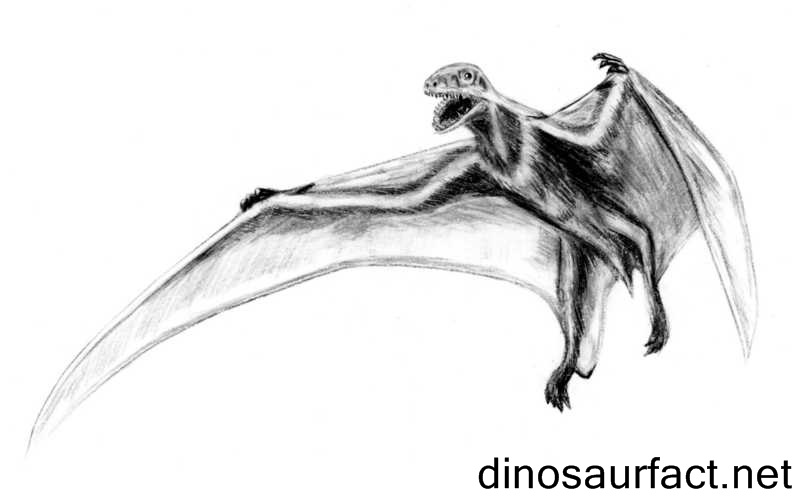
Jeholopterus was different from the garden-variety of pterosaur. It differentiated from other pterosaurs by its unusually sharp and large claws. It might have got a widely articulated jaw, which it could open wider as compared to any other pterosaur. It would have got a cat-like head and a short tail. Some paleontologists believe that, Jeholopterus would have adhered to the backs of large dinosaurs and would have sucked their blood to feed themselves. But, this habit of Jeholopterus was not proved. This creature got its name from Xu Xing, Zhou Zhonghe and Wang Xiaolin in the year 2002. The scientific name of the genus is Jeholopterus ninchengensis. The term Jehol is derived from the place of China from where the fossils were found and the term pterus was derived from Greek word the meaning of, which is wings. The term ninchengensis was derived from the Nincheng County . The fossils were flattened into a counter slab and slab pair, in such a way that one part of the fossil is preserved in one part of the split stone and other parts in some other stone. The preserved parts include carbonized skin fibers, protofeathers and hair as well. The fibers are conserved around the body of the sample in a circle of light. The wing tissues are also conserved, even though the level is arguable, inclusive of the point of attachment to the legs. The arguable fact is that whether the lags are attached or not. In the year 2009, a report was published by Alexander Kellner, which shows the existence of three layers of fibers in the wing. The neck of Jeholopterus would have got seven to eight cervical vertebrae. They would have got twelve to thirteen dorsal vertebrae and three sacrals as well. They would have got five pairs of belly ribs. They are classified under reptilia class and pterosauria order. They are further classified under the suborder of Rhamphorhynchoidea under the family anurognathidae. Generally, short tail is unusual in case of rhamphorhynchoid, but they are common in anurognathids and so they are classified under the family of anurognathidae. The wing bones of Jeholopterus were healthy and they had short metacarpals. Jeholopterus would have got a curved and long hand claws. Their wing bones show that they would have attached to the ankle. They also had strong legs and the toes of the legs would have got curved claws. But, the claws in the legs are shorter than that of claws in the hands. |
The Nemicolopterus |
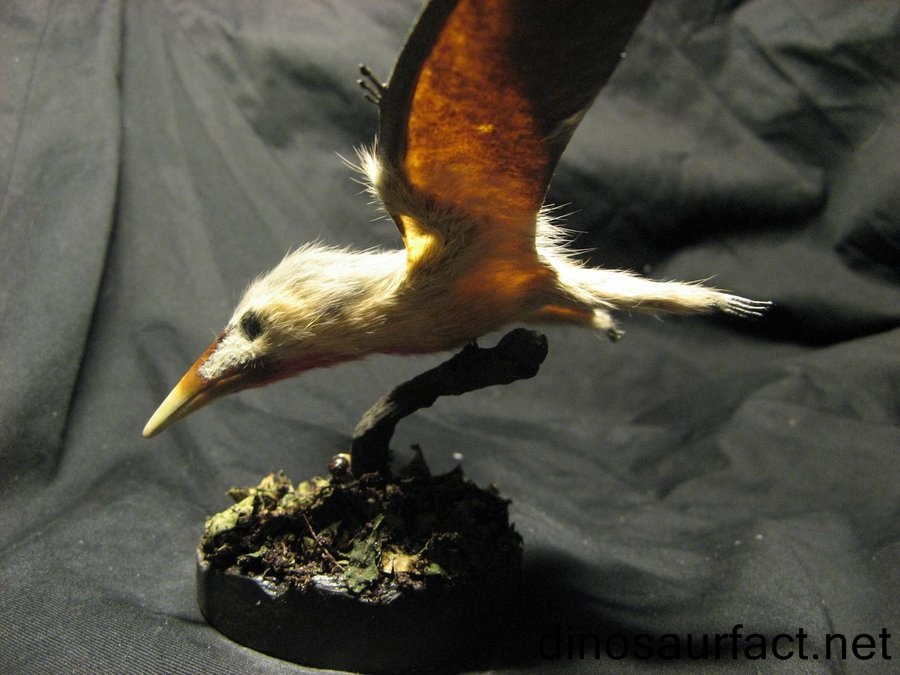
Nemicolopterus belong to the Pterodactyloid Pterosaur genus. Until 2008 we were not associated with the name. It is assumed that the species frequented in Jehol Biota about 120 million years back. It was not a giant bird; just a small one having a wingspan of 10 inches. It was even smaller than the species of the hatching pterosaurs. The specimen that was found by Wang in the year 2008 was nothing but the fragments of ossification of toes and sternum. From these fragments it was assumed that the species was nothing but a hatchling. According to Darren Nash, the Pterosaurs were highly precocial. As a result, the fusion of bones and ossification occurred at every early stage. Thus the conclusion goes thus that the Nemicolopterus might be a hatchling of the Sinopterus genus. It is assumed that the name Nemicolopteus has been derived from the Greek word forest dwellers that have wings. In Greek 'Nemos' means 'forest', 'ikolos' means 'the dweller' and the 'pteros' means nothing but 'wings'. And finally 'crypticus' means 'hidden'. Thus if we may analyze the total segments we find the group of words ' The flying forest dweller that is hidden'. We came to know of the N.Crypticus from a fossil. Beijing Vertebrate Paleontology and Paleoantropology kept it in their custody. The fossil of Jiufotang Formation belonged to the Aptian age. The fossil was discovered in the Yaolugou Town of the Jianchang County of the Liaoning province of China . We came to know that Nemicolopterus was a Pterosaur that had no tooth. According to Wang, the bird was a intermediate between the Pterosaurs that had tooth of the genus Ornithocheiroidaea and the toothless genus of he Dsungaripteroidea. Nemicolopterus was a very small bird. But according to scientists, the small birds evolved into the flying big birds like Quetzalcoatlus. Nemicolopterus used to clutch the tree branches with the tiny claws. They roamed freely from one branch to one branch. But contradictions loom large when most of the pterosaurs are retrieved from the sea bed. It highlights that the little birds not only roamed on the tree tops they were accustomed to catch fish in the sea beach. They used to sit on the rocks or cliffs near the sea water so that the fish could be grabbed quite easily. But when the question of the Nemicolopterus comes to the forefront, it is revealed that it was such a small bird that lived on insects. They used to spend time roosting on the trees in leisure time. |
The Globidens |
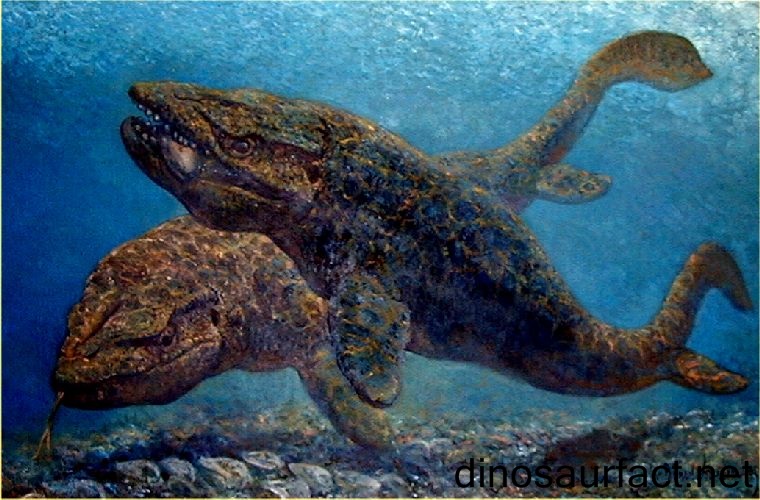 Globidens are marine reptiles that belong to the Triassic era. They were survivors of the earth about 215 million years ago. The globidens were a part and sect of the mosasaur lizards. They were the largest living lizards. The fossils of the Globidens indicate that they were about 20 feet (i.e.) 6m in length and they had sharp teeth . But, researchers could not find out the weight of the dinosaur. Fish were a major part of the diet of Globidens. These lizards had flippers along with a long tail and neck. Their heads were pointed. The fossils of the Globidens indicated that it had spent most of its time under water, but it crawled onto the land with the help of its strong legs. The Globidens had more or less the same appearance as mosasaur lizards since it had the same type of flippers, powerful jaws and laterally flattened tail. In the year 1912, Gilmore is the first person to describe about the Globidens. The second species was described in the year 1975 by Russel and the third species in the year 2007 by Martin. The Globidens had flattened limbs which functioned as hydrofoils. The hind limbs of the species of dinosaurs were less significant and they helped in surface control and in stabilizing like sea turtles. It has moreover been seen from the bones of its limbs that these dinosaurs crawled through the water beds just like the small freshwater turtles. The pectoral girdles of the Globidens were mightily built and the girdles made it possible to attach the strong muscles. And the researches showed that the pectoral girdles were located under the shoulders. Hence, they were used by the dinosaur species for swimming. Apart from the speciality of the limbs of the Globidens, the tail bears a resemblance to aquatic reptiles. The powerful tail muscles enabled the amazing species of dinosaurs to heave it from side to side along with a control to use it as a weapon as well. Globidens are regarded to be ovoviviparous, which means that they reproduced by eggs which developed inside the body. The fossils of Globidens displayed a deficiency in ossification and a basic elbow joint in the progression of olecranon of the ulna. Such a feature has enabled these dinosaurs to crawl over to the beaches during the egg laying process. The specimen was found in similar type of deposit and at altered developmental stages in and around the same locality. Hence, it is believed to sustain an ovoviviparous model. But, the fossils of the female Species of the Globidens indicated that it had foetuses inside the lower segment of the thoracic cavity. So there were a lot of details found about these dinosaur species from its fossils. But, some of the conclusions are still unsolved. The Globidens evolved during the dinosaur era and ruled as the water lords. They were strong and had all the weaponry and armour in their body. If you wish to gather more details about this amazing species of dinosaurs. |
The Hatzegopteryx |
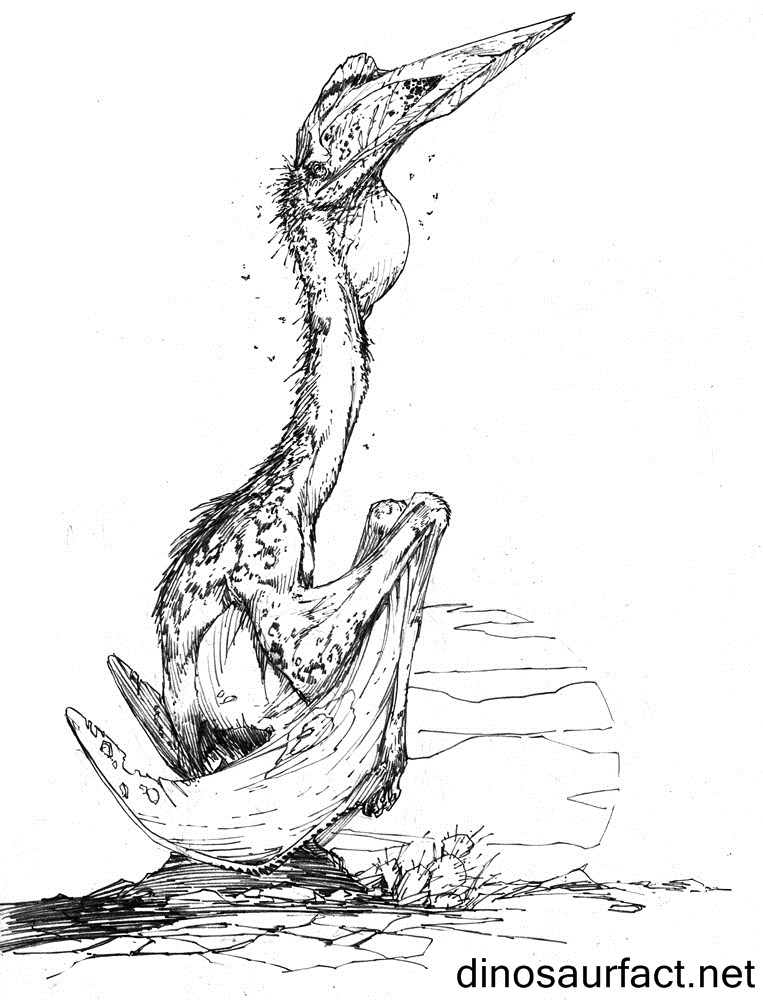
This species received this name in the year 2002 from Romanian Paleontologists Zoltan Csiki and Dan Grigorescu and French Paleontologist Eric Buffetaut. Its biological name is Hatzegopteryx Thambema. The term Hatzeg was used to denote the basin of Transylvania called Hateg Island and the fossils of this species were found from here only. The term pteryx is a Greek word pteryx and the meaning of the term is wing. The term thambema was also derived from a Greek word and the meaning of the term is monster. The name itself refers that it was a huge sized species. Hatzegopteryx was known to have lived around 65 million years ago, during the late Cretaceous period. The fossils contained the damaged proximal part of a left humerus and the back part of the skull. From the same area, researchers also found a femur of about 38.5cm long and they assumed that it would also have been belonged to Hatzegopteryx. Generally, the skull of pterosaur would have been made up of lightweight struts and plates, but the skull of Hatzegopteryx was heavy with its robust construction. With the heavy weight of the skull, researchers assumed that it would not have been able to fly. But, the wing bones of this creature have some similarities with that of flying pterosaurs. So, they decided that for the purpose of flying, the weight of the skull of this pterosaur might have been reduced by following some unconventional methods. They also suggested that they would have been able to reduce their weight with the help of internal structure of the bones in the skull, which were full of small hollows and pits up to 10mm long. This was partitioned by a matrix of thin bony struts and they were able to find this feature in some part of the wing bones of Hatzegopteryx as well. They concluded that this would have allowed a stress-resistant construction and this would have remained lightweight, enabling them to fly. The researchers anticipated the size of Hatzegopteryx by associating the humerus fragment of Hatzegopteryx with that of the humerus fragment of Quetzalcoatlus. The humerus of Hatzegopteryx was 263mm long, while that of Quetzalcoatlus was 544 mm long. With this comparison they estimated that Hatzegopteryx would have been slightly longer that Quetzalcoatlus. They also noted that the wingspan of Hatzegopteryx was about 12 meters, while in the case of Quetzalcoatlus, it was about 20 meters. Finally, they came to a conclusion that the skull length of Hatzegopteryx would have been 2.5 meters, while its wingspan would have been twelve meters. Hatzegopteryx was classified under the kingdom of Animalia with chordata phylum. It is further classified under the class sauropsida with order pterosauria and suborder pterodactyloidea and it was known to have belonged to the family of Azhdarchidae. |
The Henodus chelyops |
 Henodus chelyops are also known as” Turtle-Faced Single Tooth". Henodus chelyops was a type of placodont, which during the Carnian stage of Late Triassic period. The relics of Henodus chelyops were found in Germany and Tübingen. The length of the fissile was around 3.3 ft that means 1 meter. The original name of this dinosaur is just henodus and henodus chelyops is its biological name. This has received the name from Von Huene in the year 1936. Henodus Chelyops is classified under the kingdom of animalia, under the phylum chordate and class sauropsida. It is classified under the superorder sauropterygia, under the order placodontia. Henodus chelyops was nothing, but the placodont that had the maximum similarity to the modern turtle. It also had a shell produced from a plastron on the underneath and a covering on the top portion. The exterior portion is well extended further than the limbs, and was prepared by different plates of bony scutes and plated by covers of horn. On the other hand, the shell was created by several pieces of bone and the number of bones was higher when you compare this to the turtles, forming a medley prototype. The protective covering was combined to its back, and its limbs were positioned in the usual positions, different from the turtle, where they are positioned within the ribcage. The feeble limbs of Henodus chelyops propose it tired little, if any time on ground. Henodus chelyops are considered to be ovoviviparous, which signifies that they reproduced by their eggs which developed inside the body. Such a feature has enabled these Henodus chelyops to crawl over to the beaches during the egg laying method. The specimen was found in similar type of deposit and at altered developmental stages in and around the same locality. Hence, it is believed to sustain an ovoviviparous model. But, the fossils of the female Species of the Henodus chelyops indicated that it had foetuses inside the lower segment of the thoracic cavity. The Henodus chelyops are also had a particular tooth on each side of the mouth, while the rest of the teeth were restored by a mouth. These teeth were plane/flat to squash bottom house shellfish. The head is square in shape and the eyes are situated ahead of the head. The Henodus chelyops are the lone placodont thus far appeared in non-marine places, telling it may have existed in salty or freshwater ponds. So there were a lot of details found about these Henodus chelyops from its fossils. But, some of the conclusions are still unsolved. The Henodus chelyops evolved during the dinosaur era and ruled as the water kings. They were strong and had enough covering for their protection on their body. If you wish to gather more details about this amazing species of Henodus chelyops , then take the help of internet. So, through the help of internet, you will be able to get millions of result showing the best information on Henodus chelyops and you can get the images of these wonderful species are well. |
The Megalosaurus |
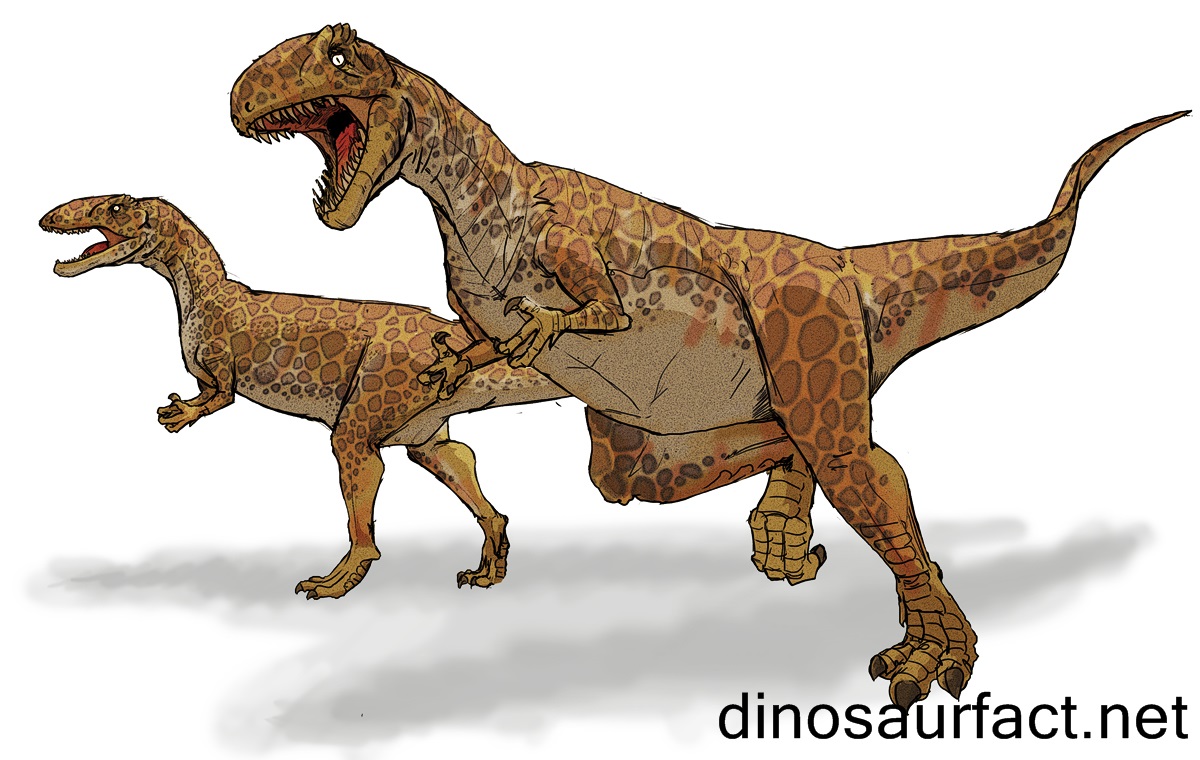 Megalosaurus – the ferocious meat eater Megalosaurus was one of the first dinosaurs to be found and named. It should be pronounced as Meg-ah-low-sore-uss. The meaning of the word Megalosaurus is ‘great reptile'. It was a large meat-eating dinosaur and was known to have been lived around 175 million years ago during the Jurassic period. It was discovered in England in the year 1676. It was named by William Buckland in the year 1824. Later in the year 1827 Gideon Mantell assigned the species name Megalosaurus bucklandii to honor Mr. William Buckland. Megalosaurus was known to have been around 30 feet (i.e.) nine meters long and it 10 feet tall (i.e.) three meters. This dinosaur was known to have been weighed around one ton. The dinosaur had a bulky body with heavy bones and long legs with clawed feet. The arms of the dinosaur were short as compared to the legs and the hand three fingers with sharp claws. It also had small bony knobs over each eye and large powerful jaws with sharp and long teeth, which enables it to eat meat. It was a fierce hunter and killer that could kill even large sauropods, which is another kind of dinosaur. It was known to be more intelligent as compared to the other dinosaurs. The intelligence was measured by its relative brain to the body weight, which is also called as Emotional Intelligence. Megalosaurus was relatively fast runner as compared to other dinosaurs. The speed of the dinosaur was judged by scientists on the basis of their morphology (i.e.) the characteristics like estimated body and leg length. The speed was also judged on the basis of the fossilized track ways of the dinosaur. Megalosaurus was a lizard-hipped dinosaur also known as saurischian. Initially, in the year 1676, a part of the skeleton of Megalosaurus was found at a limestone quarry at the city of Cornwell near oxford, situated at England. The bone was then sent to Robert Plot, who was the professor of chemistry at the Oxford University and he was also the first curator of the Ashmoean Museum. Pr. Robert plot identified it to be the thigh bone of a large animal, which was then found to be the bone of Megalosaurus. Then, more discoveries began in the year 1815 to know more about this dinosaur, which resulted in the discovery of a bone at the stones field quarry situated at the north of Oxford, which was acquired by William Buckland, who was the dean of Christ church and the professor of Geology at the Oxford University. Pr. William Buckland found some bones like fragments of pelvis, some vertebrae, hind limbs and a piece of lower jaw with teeth, which belonged to different Megalosaurus, with the help of which he found that all the bones belong to a giant animal which belonged to the lizard family and then he named it as Megalosaurus. Among the different dinosaurs, Megalosaurus was regarded as the dangerous and ferocious dinosaur since it was a meat eater. Hope, you would have understood about Megalosaurus. |
The Kronosaurus |
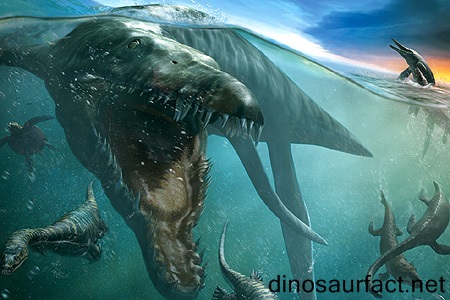 Kronosaurus was the largest marine reptile that ever lived. It belonged to the category of plesiosaur, which is a meat-eating reptile. As considered by most of us, Kronosaurus is not a dinosaur, it is a plesiosaur. It was known to have been lived in the early cretaceous period and it belonged to the Dolichorhynchopidae family. It is known to have been lived around 110 million years ago. The term Kronosaurus was derived from the Greek word and the meaning of the term is krono's lizard. Kronos was known to be the Greek god of time, who is known to have eaten his own children for the purpose of guarding his powers. The term Kronosaurus is pronounced as crow-no-sore-us. Kronosaurus is known to have been lived in the country of Australia and it was a highly skilled swimmer. Apart from Australia , these plesiosaurs would have been lived in South America and Columbia as well. The fossils of Kronosaurus were found in Queensland , Australia in the year 1889 and it was found by A. Crombie. It was named in the year 1924 by Longman. Kronosaurus were known to be the ferocious predators of the sea and it would have been lived in the open oceans, but would have also required swimming to the surface since it was an air breathing reptile. They might have been able to move a little in the land like seals. From the fossils of Kronosaurus, it was found that it would have got a pointed tail, short neck with four long flippers and a huge head. It has a rounded teeth and strong jaws and tooth of the Kronosaurus was so strong that it would easily crush the shells. The four paddle-like flippers had enabled the Kronosaurus to move around water like sea turtles. The diet of these plesiosaurs was large squids, ichthyosaurs and sharks. It was known to have been around 30 feet (i.e.) 9m long. The head of Kronosaurus alone was around 9 feet (i.e.) 1/3 rd of the total body length. It has been found that it would have been weighed around seven tons. Even though, the Kronosaurus were known to have been lived in oceans, it would have swim to the surface for laying eggs as is being done by turtles nowadays. Like turtles, Kronosaurus has also laid eggs in nests dug in the sand. According to a research Kronosaurus made its living just like the present day shark in such a way that it had eaten every all animals living in the water coming in its way. It has been found that it did not restrict itself in eating just squids and fish, but feasted occasionally with other aquatic reptiles as well. From the fossils of Kronosaurus, researchers have found some stones in their stomach and they assumed that these stones might have been consumed by the Kronosaurus for grinding up their food or the stone might have also been used as ballast for the purpose of diving. Hope, you might have got the required information regarding Kronosaurus. |